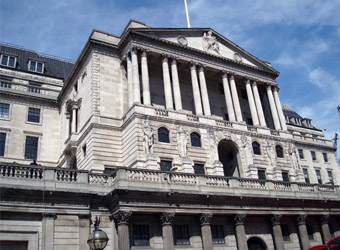It is a curious thing that while the Federal Reserve garners much hatred in the U.S., the same is not true of the Bank of England in its homeland.
Both are, of course, among the most important central banks in the world. But maybe the sour view of the Fed comes from American animus toward all central banks.
Whatever the reason, the Bank of England holds a special place in the psyche of Britons. That fondness is no doubt enhanced by the majestic building in which it sits at the heart of London’s financial district.
Its story is detailed in “Till Time’s Last Sand: A History of the Bank of England 1694-2013,” by David Kynaston, a book set to be published in the U.S. in November. In Britain, it was out in September under the same title.
The BoE was founded as a private enterprise in 1694. It focused partly on lending money to the government to finance yet another war, a persistent pastime of European nations for millennia.
Kynaston’s book gives a blow-by-blow account of the bank through the auspicious founding of the institution through crises through its 1946 nationalization through its eventually securing independence in matters of monetary policy, right up to the recent financial mess of 2008-2009 and a bit beyond. In short, there’s a lot to tell, which explains why the book is more of a tome, running at close to 900 pages, so give yourself time to read it.
The aftermath of the 2008-2009 meltdown has brought forth enough nauseating love letters to central bankers to last a lifetime. Fortunately for readers, Kynaston doesn’t fall into the same toffee-laden dessert bowl. Instead, he presents a balanced account of what amounts to a whole lot of history.
Whatever you know about the Bank, or of Britain, this book is sure to hold something for you.
Take, for instance, a financial crisis few discuss. It was the sparked by the outbreak of WWI in 1914. It included what amounted to a bank run with people, “flocking to the Bank of England to change notes for gold.”
That was just one problem. The other was to finance the war (yes another war.) Needless to say, the run abated, and the money was found, perhaps it shouldn’t have been given the eventual slaughter of a generation of young men on the continent.
There are some nice touches in the book including an account of the bank’s governor from 1918 to 1920, Brien Cokayne, who never discussed business or the bank with his family. Apparently, this gave Cokayne relief from the pressures of the job. Perhaps that’s something we should all learn.
For me, an insightful part of the story is the British account of the aftermath of Nixon ending the gold standard in 1971. “They were an extraordinary couple of years,” states the author referring to the period of 1971 to 1973.
During that time British lenders had no shortage of borrowers, with U.K. residents growing by at least 148% over the period. Where did they use the cash? Real estate and finance, of course.
Believe it or not buying homes was a rational decision given that when the U.S. ditched the gold standard, all currencies in all countries were devalued, and mass inflation ensued. If you bought a house, then you would still have a home no matter how much the spending power of cash declined. So much for irrational decision making.
Even if you can read 900 pages in a day, Kynaston’s is a book you’ll want to keep around. Source: Forbes
Source: Forbes
